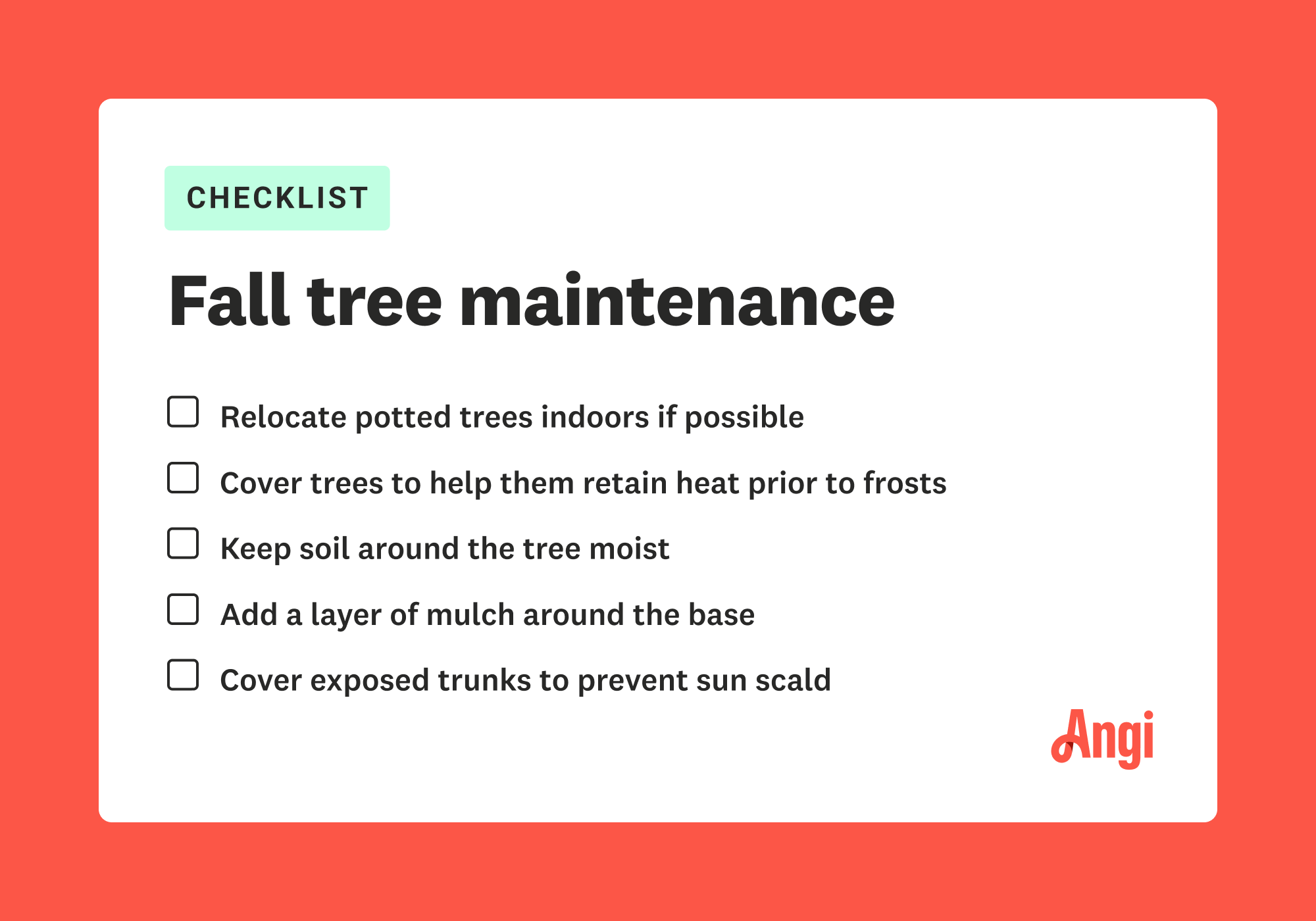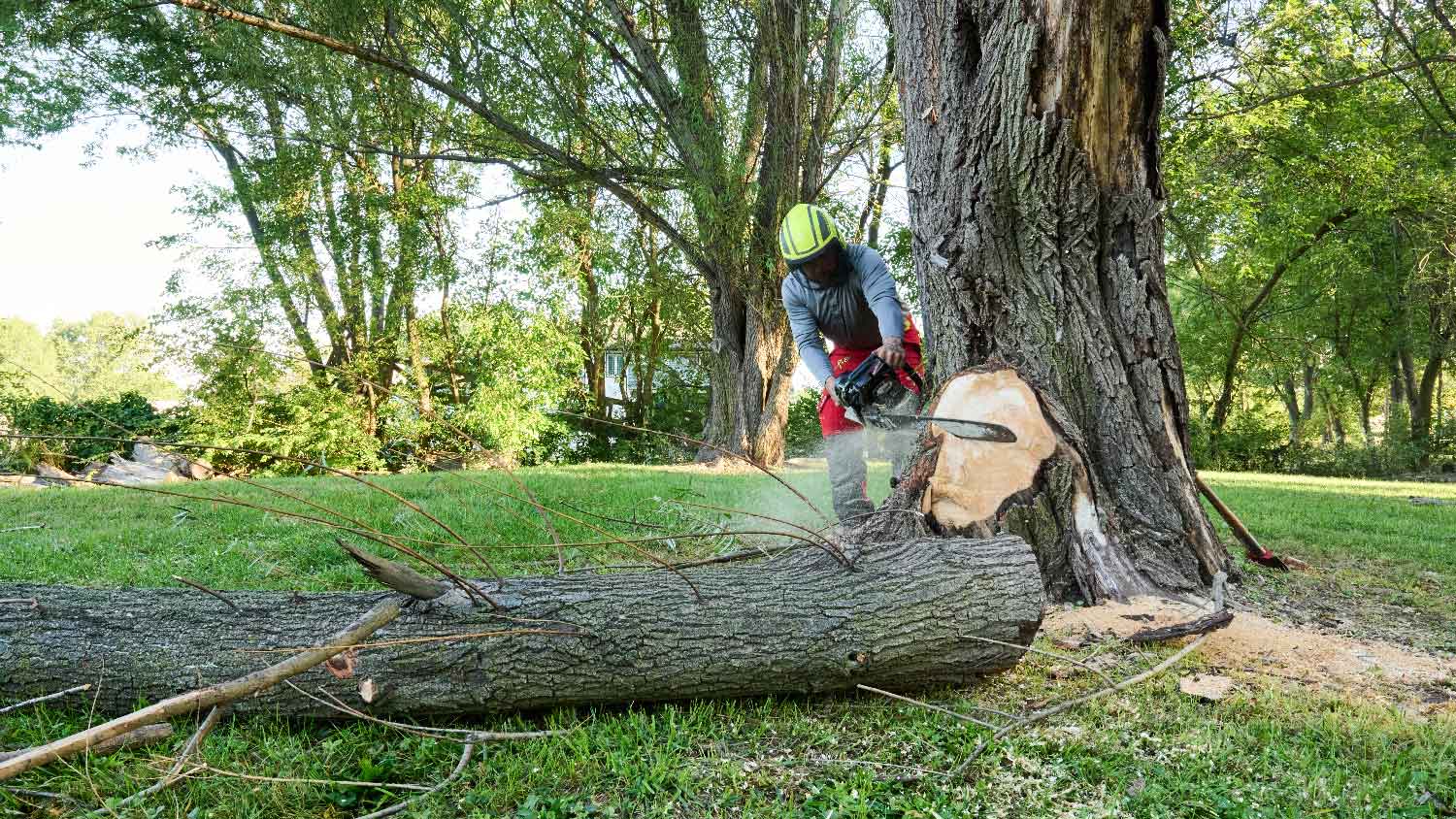How to Protect Trees From Frost and Prevent Damage
Winter is coming: Get your trees ready


An early fall freeze, a late spring frost, and the rare cold snap in a warm climate can claim the lives of your trees if you’re not careful. Learning how to protect your trees from frost is an essential skill, especially if you live in a cold climate.
While the mature trees in your yard can withstand the bite of winter, frost can damage newly planted saplings, turn unharvested fruit to mush, and deal a death blow to a potted tropical tree. Luckily, there are measures you can take to save your precious trees from the icy grip of Old Man Winter. Here’s how to protect trees from frost.

1. Bring Potted Trees Indoors
If your tropical tree is in a pot, and that pot is small enough and lightweight enough to lift and move, then protecting it from freezing temperatures is relatively easy. Like the snowbirds that flee the North when the weather turns cold, relocate that ornamental orange tree into a climate-controlled area until the threat of freezing passes.
If the temperature is only going to dip a few degrees below zero, you might be able to get away with moving the tree into the garage. Garages typically stay a few degrees warmer than the outside air during winter. If you have an insulated garage door, then your garage likely stays even warmer.
If moving your potted tree indoors simply isn’t an option, then move those potted trees close to the walls of your home. Buildings produce reflective heat that keeps the surrounding air a few degrees warmer.
2. Cover Your Trees Up
Covering a tree can help it retain heat. But, rather than using a fleece blanket like you would for yourself, cover the tree with something like burlap, old sheets, or a tarp.
By completely covering the tree, the cover can trap heat coming off the earth, keeping the temperature under the cover warmer than the outside air. While any type of covering will do, it must be large enough to extend all the way to the ground around the tree to hold heat inside. Since the cover can potentially damage the tree’s branches, use wooden stakes or build a wooden frame to limit the amount of contact it makes with the tree’s foliage.
The best thing to use to protect trees from frost is to cover them with a “frost cloth.” This type of cloth is made of materials like polyester or polypropylene and it’s designed to cover and protect trees and plants. While you can use objects such as sheets and tarps, they can be too heavy to support the tree.
Frost cloths can vary in thickness and weight. Lighter cloths are breathable and protect against light frostings, and heavier cloths can protect against more frigid temperatures. You will need to secure it to the ground with stakes or heavy objects to prevent it from blowing or falling off of the tree.
3. Water The Tree
Moist soil better absorbs and radiates the sun’s heat than dry soil. With that in mind, water the earth around your trees liberally. If you can, water when temperatures are coldest between 4 a.m. and 6 a.m. Resist the urge to set up a sprinkler or run your irrigation system. Water that collects on branches and foliage can freeze, damaging foliage and branches. Also, you may need to winterize your outdoor plumbing after watering to ensure the cold doesn’t damage it.
4. Mulch the Base

Add a thick layer of mulch around your trees in the fall. The mulch will prevent moisture loss and act as a layer of insulation that helps keep the roots warm when winter arrives. If possible, keep the area under the canopy of your tree free of turf and weeds, as bare earth does a better job of absorbing heat.
Mulching will also protect young trees from frost heave, a process where the soil freezes, thaws, and refreezes repeatedly. This constant freezing and thawing cause the tree’s roots to rise out of the ground, where they become exposed to damaging winter weather.
5. Keep Your Trees Healthy
A healthy tree is a hardy tree. Make sure you care for your tree throughout the year with proper watering, fertilizing, and pruning. Giving your trees a little TLC will ensure they’re stronger and, hence, better able to fend off the cold when winter arrives.
6. Protect Them From the Sun
It may sound odd, but protecting trees from direct sunlight can save them from sub-freezing temperatures. When the sun shines directly on a tree trunk in the winter, it warms up the tree's dormant cells, causing them to become active. When the sun sets, those active cells can quickly freeze and burst, causing a large crack to form on the trunk.
Protect the trunk by wrapping it with a trunk guard or kraft paper. The covering will prevent the tree from awakening by keeping the trunk cool on sunny winter days. Keep the warp in place until after the last frost of the season in the spring.
7. Hire a Pro
Protecting your trees from frost is a task you can take on yourself. If you are covering them, you may have to purchase some supplies, such as garden blankets, frost cloths, and burlap. Remember, mulching around your trees can help protect the roots from freezing temperatures.
Of course, you can always hire a tree maintenance professional near you to ensure your trees are properly protected from the harsh winter elements. Landscapers typically charge between $50-$100 an hour, depending on the job and location. However, hiring a pro will free up your schedule for other projects and activities you want to do.
Tips for Dealing with Frost Damage

Even your best efforts to protect your trees from frost damage may fail. Don’t panic. All may not be lost. You can still salvage your frostbitten tree by identifying the damage and taking measures to repair it.
Resist the urge to prune: While you may think you’ve identified all the limbs and branches that have succumbed to winter’s bite, you could very well be wrong. Stay your hand with the pruning shears! What looks like dead plant tissue may simply be dormant. Wait to prune off dead limbs until spring arrives, and you can see what’s sprouting and growing and what isn’t. If you don’t feel confident pruning a tree on your own, then consider hiring a professional arborist near you.
Wait for new growth: Don’t panic if those darling buds of May wither and turn black after a late spring freeze. If nature’s first green turns from gold to black, fresh growth will usually replace this dead foliage after it falls off.
Salvage frostbitten fruit: Sometimes there simply isn’t a way to prevent fruit from succumbing to frost; however, that doesn’t mean it’s a total loss. Harvest those mushy apples and peaches before they begin to rot, and use them for juicing or making jam.
Repair damaged bark: Check for any cracks in the bark. If the tree has suffered damage, there are measures you can take to repair the bark and ensure it survives and thrives for years to come.
Why Do I Have to Protect Trees From Frost?

Worst case scenario, frost can kill a tree. It can also ruin next season’s fruit and cause damage that not only looks unattractive but also weakens the tree, making it more susceptible to disease and pests. Signs of frost damage include:
Cracked tree bark: Deciduous trees shed their leaves in the fall, exposing them to the sun. This process can trick tissue beneath the bark into thinking spring has arrived, causing it to become active. Those active cells swell and burst when temperatures drop below freezing at night, creating a large vertical crack that extends down the trunk.
Shriveling leaves: Freezing temperatures can make leaves shrivel and turn brown or black. This type of damage often occurs when there is a frost in late spring after new growth has already sprouted.
Mushy fruit: Cold temperatures cause the cell walls in fruits to expand and burst, turning a firm orange or apple into mush.
Which Trees Are Susceptible to Frost Damage?

Trees that thrive in colder climates can endure when the mercury dips below zero. Deciduous trees shed their leaves in the fall, an annual ritual that allows them to preserve water when their roots can’t draw moisture from the frozen ground. Coniferous trees have cold-tolerant thin, waxy needles that help the tree retain water during long winters. And many mature trees have thick bark that functions like the insulation in the walls of your home, keeping the living tissue inside the trunk from freezing.
But, some trees cannot winterize. Young trees with thinner trunks and yet-to-develop thick bark are more susceptible to extreme cold than adult trees. And trees native to tropical and subtropical regions never develop these winter adaptations, leaving them vulnerable when Jack Frost is nipping at their limbs.
Trees that can’t tolerate cold temperatures for long include:
Citrus: While cold hardiness varies among citrus trees, orange, grapefruit, lemon, and lime trees generally won’t tolerate prolonged exposure to temperatures under 32 degrees Fahrenheit. Frost can spoil fruit, while an extended freeze can kill an entire citrus tree.
Oleander: This small flower tree and shrub that’s popular throughout the South can survive colder temperatures down to 15 to 20 degrees, but it will suffer damage at or below these temperatures.
Jacaranda: This South American tree produces beautiful lavender flowers, making it a popular tree along the southern half of the U.S. from California to Florida. It can tolerate temperatures as cold as 20 degrees but won’t survive weather that frequently drops below freezing.
Eugenia: This evergreen that is a popular tree for property lines can survive occasional dips below 32 degrees. However, prolonged exposure to freezing will kill the Eugenia tree.
Palm: These icons of tropical locales vary in their cold hardiness. Some can handle temperatures down to 10 degrees, while others suffer damage well before the mercury drops below 32 degrees.
Apple: Most species of apple trees are hardy enough to handle the cold, but the fruit is another story. Apples will endure temperatures down to 28 degrees, but prolonged exposure to colder temps will cause the skin and flesh to soften.
Peach: The peach tree is tough enough to survive sub-zero temperatures, but not the blossoms that appear in the spring. Peach blossoms and young fruit are vulnerable to temperatures under 28 degrees.
Frequently Asked Questions
Watering trees and shrubs before a frost can help nourish them so they survive the winter. However, you need to ensure you time the watering and amount just right to avoid risking frost damage. You should aim to water a couple of days before a frost. And don’t wet the foliage, as it can cause frost damage if they don’t dry in time.
Garden blankets and frost cloths are the best things to use to protect trees and plants from frost. They are made from polypropylene fabric, which is lightweight, breathable, and dries fast. If you can’t get garden blankets or frost cloths before the freeze, you should use lightweight blankets, sheets, or towels.
The quickest way you can protect plants and trees from frost is to cover them with garden blankets or frost cloths. Also, bringing potted plants or trees indoors is much simpler than trying to cover and protect them outdoors. Remember to anchor blankets with something such as sandbags, fabric pins, or rocks if the forecast calls for strong winds to keep them from blowing away and exposing your trees and plants.





- 9 Ways to Protect Your Trees From Winter Storms
- Here’s Where To Plant Trees In Your Backyard
- How to Help Your Trees Survive a Drought
- When To Cut Down A Tree: 13 Ways To Tell
- When is the Best Time to Plant Trees?
- 8 Spring Tree Care Tips for a Lush Yard
- How to Straighten a Tree That’s Leaning in Your Yard
- 7 Reasons Why You Shouldn't Plant a Tree in Your Yard
- Can You Cut Down a Tree on Your Property?
- Why Do Trees Die? Here Are 9 Common Causes










